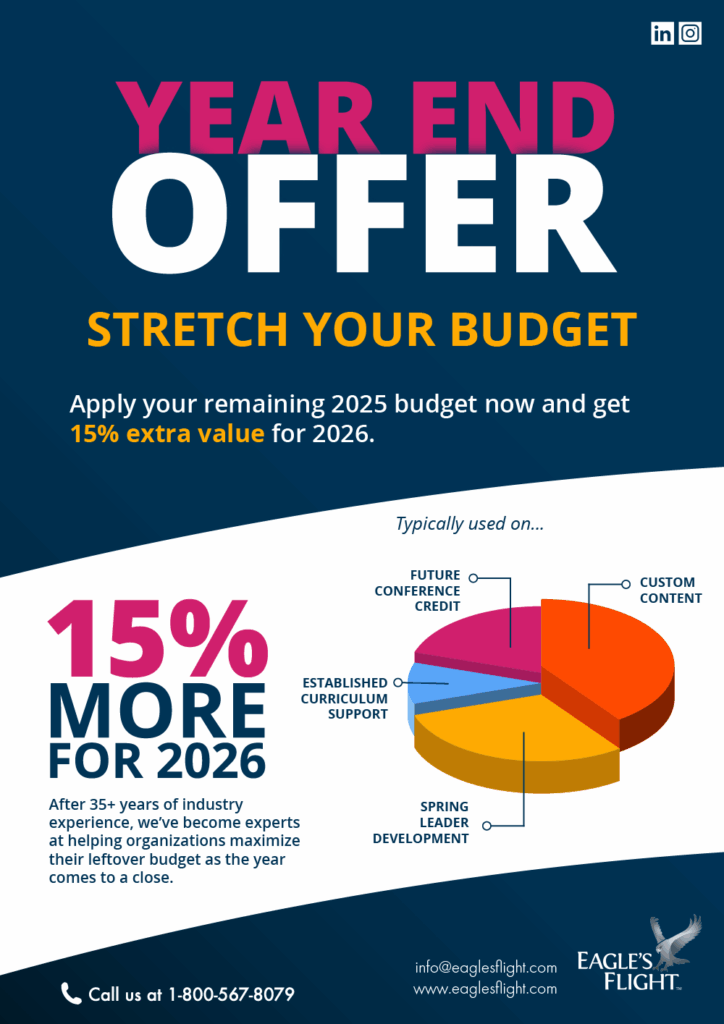[VIDEO] Leadership Development Seminar
Video Transcript:
I’m frequently asked that if we’re going to invest as a company in our leaders and begin to develop them and build a bit of a leadership pipeline, what are some things that we need to bear in mind? How, how should we craft a development program? What should be the content? How should it work? Like? How do we actually guarantee that the effort and the money that we are going to put in developing our leaders actually is going to have the desired outcome? So with that idea in mind, I’ve put together some thinking that certainly from my experience has been a help with that.
To kind of guide you in the creation of your leadership development program and I think it begins with understanding that for most people they start in their career and they are skilled functionally. Let me take a simple example. I might get my first job working on a road crew and and I do my job well. I my job is to. Dig the ditches, sweep the roads, carry the wheelbarrows. Whatever is necessary to do that job at an entry level. Perhaps I’m a summer. Student. But I do it well. And next summer, they make me a lead hand. And so now I have a little more responsibility. I have a summer crew working for me and I’m still working. I’m still working on the crew. I might be operating the the backhoe or whatever, but I I’m a functional guy. I I work on the road and I, you know, I I do the work that needs to do and I guide the crew beneath me. But but I do a good job, so I get promoted.
Then and now, I become a supervisor and as a supervisor I’ve got a number of lead hands working for me. I’m still working on the crew. I’m managing the trucks, perhaps driving some of the trucks, working some of the heavy equipment, and I’m still managing teams that are managing teams and we’re on the road. We’re doing well and I’m doing a good job and I get promoted. Well, now I’m kind of like a manager and I spend quite a bit of time in the trailer over on the side here where I begin to do the work planning and begin to do some organizing. And I think about recruiting and I have the crews working beneath me and then I get promoted again. And before you know it in due time a number of years later, I’m now the CEO. I got promoted primarily on the basis of my functional skill. However, if we go back to my first job, when I was just working on the crew as a summer student at the end of the day, I’d go off and maybe have a beer with the gang, and then I get promoted. And yeah, I mean, I’m still having a beer with the gang, but then one or two of them are coming to me saying, you know, Phil, what do you think about this? And should I do that? And I go well, you know, that’s not really the way to do it. And I I beginning to provide a bit of coaching and guidance and I get. My next promotion, and now I’m beginning to say, you know, you really need to be thinking about this and this quality isn’t high enough and you need to manage your time differently. And as my career progresses. My people skills move from drinking beer to actually having to manage a large organization with a lot of people. So somewhere in that journey I made the transition from primarily A functional person to a people person primarily worrying about. Functional things to worrying about people, things. And as my career continued to grow, my functional responsibilities became less and my people responsibilities became higher.
This is typically what happens. Yes. But you think about that the skills that are resulting in my promotion are functional skills. And so I am transferring those skills. Over to how I manage people, because that’s all I know. I’ve never been trained to lead people. Well, I’ve been equipped, trained to operate equipment and so I’m managing people in much the same way as I manage equipment and by the time I get to a senior level, unless I’ve been properly trained as a leader, I’m still thinking about people as things. And that is why so many organizations have leaders who are not great people, managers because fundamentally their career has been as a result of. Being great functional. Folks, and they simply transferred those skills over.
Now they picked up some leadership training along the way and so on, but it’s spotty. What really should happen is there should be a major focus on equipping those emerging leaders with the skills of leadership. So while they’re functional skills are causing promotion, their people skills are growing and growing. So by the time they make the transition, where they’re more focused on people. They’ve got a strong set of skills and they continue to be trained as they continue to get promoted on how. To be skilled at. People rather than functions. So behind your leadership development strategy needs to be that mindset which says we need to equip right from the beginning. Our folks with how to be great people, managers and not just rely on their functional skills. One of the things which I’ve thought about in terms of how to help people make this transition and build in the sort of. Is to think in terms of emerging leaders, which I would might call supervisory folks, and then you have mid level and then you have senior level and then you have executives and what you need to do is build training that’s appropriate for each of those levels. And typically I think of it in three categories, there are level specific skills. So if I am a supervisor for example, then I need to know how to deal with conflict. There’s conflict on the front line. There’s people playing and don’t understand, and you know they’re not necessarily as committed as others. But at that level I might need some conflict training at the mid level. I need to do more coaching skills at the senior level. I need to start thinking about how do I lead change. And at the executive level, I need to think about strategic planning. So just as an example, the the level specific skills that I need need to be broken down into the skills I need at as I move through my career. Then you have personal developing skills, things like communication, so the communication skills I need at the supervisory level are very different than the communication skills I need at the executive level. But whether you’re talking about communication skills or project management skills or accountability, whatever it is, these developing skills.
Need to match my level and then the third area is functional skills. So these are skills that are very specific to my function. So if you take for example building and leading teams, the the teams that I build and lead at the supervisory level are very different as they move through the ranks because of the more senior ranks. I’m not leading teams, I’m leading leaders. Who are in turn leading leaders who are in turn leading teams. So my ability to build and lead teams has got to migrate. So you can create a framework that is actually quite comprehensive. I’ve just given you some examples here. That help you understand, as I begin now, to equip my people on their journey of leadership, I need to be thinking in terms of what do they need at this level? What skills specifically do they need and what are the functional areas that they need and build that out accordingly. The next thing to think about as you created your leadership. Curriculum if you will your pipeline to equip your leaders as they migrate through their career, you need to be sure that the programs that you provide. Have what I call a spider web framework. So for example if I am learning to coach in one course and learning to set goals in a second course, those two should not be distinct. When I learn to coach, I need to reference. That was taught in gold.
Setting so that I am actually coaching about how do you set clear goals that actually work. So I learned how to set goals and now I’m managing somebody setting goals and I’ve got to coach that person. I need to coach them against that goal setting in the doing of it, I’m going to have to be a good listener. On my training on listening. Needs to also have linkage into coaching and linkage into goal setting, so there has to be an integrated approach to your leadership training package so that that they are not all discrete events. So that I as the leader don’t have to figure out, OK, I learn this communication skill but. And I’ve learned this coaching skill, but how do the 2GO together you need to equip me with that? Because then you get the synergy and the effect is much greater.
Practically speaking, when you do that for your company, there will be some strands that are, you know, how. When the spider builds the web, there’s there like one of the strands that’s going to connect up to the various places. So there’s like these major strands that are what I think of as linking strands. And then they build all the little web in the middle. So in your organization. You will have some linking. Friends and some that are, if you will, more interconnecting strands. So for example, you may be in an organization where coaching is really important and accountability is really important and strategic planning is really important. So they become linking strands and other things like listening or goal setting become more of the interconnecting. Grants or in your organization and on our goal setting is absolutely critical for us. Setting priorities and managing time is absolutely critical and they become the linking strands. So just as you do the design you need, OK, what are the things which we absolutely have to be sure to get right?
Those are the linking strands. And then the other topics which are important. We just simply show how they are all interconnected. To support those major linking strengths. So in your design, you want to be thinking about that spider web as a very cool way to get the maximum benefit from your training investment. Once you’ve got your curriculum designed and you’re equipping your leaders for their journey of leadership through your organization and you’ve thought through about what’s really most important, and you’ve developed a spider web structure, you then need to pull back and say, OK, our goal here, the objective of what we are trying to do. Is competency improvement. Not training. So you know how you very often think well, you know, it’s just a check in the box. We’re just trying to get people in seats. We’re just trying to get people through training. That is really the kiss of death. What you really want is competency improvement, competency improvement means I know what to do and I know how to. Do it. So I may read in a book how to go about. Joining 2 pieces of copper pipe so that they don’t. Leak but when I. Actually go to do it. It’s not that easy and I need a more experienced person to show me, and I need to practice it so that I get it right so that when I go into the homeowner and I repair their pipes, they don’t leak. Knowledge of of what to do is important. But the skill of how to do it is also important and when I put knowledge and skill together I have competency, so training people and giving them knowledge without the opportunity to practice is really not very effective and very often training has got an emphasis more on the passing on of knowledge and less on the passing on of skill.
You need to put the two together and it’s easy when you think of something like copper piping, it’s not so easy when you’re thinking about listening or communication or project management or strategic planning or accountability or empower. So your organization needs to build training that actually provides competency, not training. And the way to think about this is I once had a boss who said, Phil, I will not pay very much for training. I’m not interested in paying for training. But I’ll pay a lot. For the results of training. So that has driven me for years because providing training is not the goal. The results of training is the goal. So as you build your training curriculum, as you begin to put courses in place, as you begin to try to equip people with the behaviors to become truly world class, you need to think more. About the results of training the competency improvement and less about the training, that is not really the focus. The focus is the outcome of the.
For that to happen, people actually need to acquire behaviors. And for people to acquire behaviors, whether new behaviors or getting rid of the old behaviors that were not very productive and getting new behaviors requires 4 things to truly improve competency, you need conviction. If people do not feel. That learning this new skill and becoming more competent is worth it. They won’t do it any more than your your kid doesn’t understand that they’ve got to clean their. Room. They’re going. To do it, unless you constantly threaten them with taking away their TV or something, they need to understand the value of that they need to have a conviction about the value. I can always find my toys. I can always make sure I have everything that I just got for Christmas or my birthday in one place, and I know where to get it or whatever it is that you just sue to help build conviction with children. The issue here is you have to build conviction that the new behaviors that you are teaching. Are going to make a difference and make them better on their journey that they will be better able to lead, better able to harness the potential of their people, better able to get folks to come and bring the best that they have to the job every day. That’s what a great leader does. Then you have to provide knowledge which I’ve talked about, which is helping them under. And sort of what to do. Then you have to give them application the skill to apply that knowledge and then you have to hold them accountable for results.
Very often training says, OK, we’re going to train people. We’re going to put them in rooms. We’re even going to give them practice and we wish them the best. But we’re not doing this out of the. Goodness of our heart. We’re doing this so that you will be a better leader and produce better. Else so you have to put the responsibility for the application of that training on the people getting the training so that they go away and produce better results. So to simply give them information or training without putting a results based expectation on them. Is not going to get you the behavior change that you’re looking. So all through my leadership journey, the model you should be following is heart convection. Head Knowledge, hands application and harvest results. And I say heart head hands harvest because it’s much easier to remember than application conviction and all those kinds of things.
So that’s kind of the model. To follow. Once you have initiated training and you’ve put people through that the program and they feel like they’re part of this journey and they’re going to actually become a world class leader one day as a result of the training which you’re providing them and you’ve made sure that you build conviction in and knowledge and. Application and results. You then are facing a problem in the real world. The case that’s in and it doesn’t matter what it is. If I learn to operate my. Television that I just bought that’s got a million buttons on it today and then I don’t watch TV for six weeks, six weeks or not. I can’t even remember. I can’t remember where the manual is, let alone how all the buttons work. Just human decay sets in. Whether you’re learning a sport, whether you’re learning a skill, whether you’re listening to somebody speaking. Human decay sets in we for. Forget and it’s not just that we forget other things come into us and those new things that come in overlay the previous things. So I’m learning to operate my TV today and then I’m learning to operate my lawn mower tomorrow and then I’m learning to operate my car the next day. I can’t even remember, so it’s very hard for the learning. Which you are giving folks that you want them to apply to actually stay top of mind. So what you need to do is be sure.
After that, after the training, you do things to address that decay curve. Now Eagles Flight is a big proponent of experiential learning. It’s what we use when we do our training. So you are a long ways down the path of it being memorable experience and learning builds conviction, which as I’ve told is really important. Makes it to results, which I’ve told you is really important and it’s memorable. So experiential. Learning will help. Help with making sure that the training actually is remembered and used, but it is not the only thing that you you have to do. Other. Things. So you need to be in aware that as you begin this leadership journey, equipping people to be great, yet you have to address this decay, which naturally occurs so that they are then able to remember.
And use and apply what you taught going forward. So simply providing training. Without this, the application and retention that follows afterwards means that the initial thing will not produce the level of results you were looking for. Sustained reinforcement is critical to truly changing behavior for the long term. Let me give you an example. Let’s. Say I walk. Into a boardroom and I have a glass of water with me and I unfortunately spilled water. Wow. You look at the carpet and there’s this dark stain where I spilled the water. Now, if the housekeeping crew were to come in in the next 10 minutes saying, oh man, there’s a stain, we’re going to have to clean that up. But later that night, when they come to clean it. Up this thing’s. Gone. It’s just water. It evaporated. On the other hand, if instead of spilling water, I happen to have a bottle of Indian ink and I spilled the India ink on the carpet, I’ve got the same stain. The housekeeper still comes and says we gotta clean it up, but when they come back at midnight to clean it up, it’s not. Went out India ink is there. It is permanent. It has stained the carpet. So what, you want your training to be like is not like water, which looks like it’s actually made an impact. But a few hours, days or weeks later it’s actually not much of an impact. You want it to be. Like India Inc, where the impact is permanent, so to do that there’s a number of ingredients just to cover off quickly to give you a sense, the first is you need executive support, whatever you’re training your leaders on, you want to be sure that your executives are reinforcing that and saying that’s important and we expect those behaviors so.
The body follows the head, so the executives need to support the kinds of behaviors you’re training. The second thing is you need the line manager. The person that I work for, my immediate supervisor, not the. Folks that are up in the clouds at the executive level, you want my immediate line manager to be a model so that I can learn by watching. And to be a. Coach so that I can learn by asking. So if my line manager is like that then there’s a much better chance that I’ll begin to practice the behaviors that I was taught the third. Is I mentioned earlier that. You need to link results to the training, so there needs to be a clear accountability on results, whether it’s improved customer focus, improved focus on sales, improved results around whatever performance metrics we use, whatever. Whatever way we think about measuring our culture, whatever it is that I am expected to demonstrate. An improvement in as a result of the training or a skill in it. Needs to be measured. The 4th is you need feedback. We grow by virtue of feedback and in fact Eagles flight has a very cool app designed expressly to give feedback because in the absence of feedback I have no idea how I’m actually doing. So you need to build in a feedback mechanism whether it’s an app like we would have or something else 360°.
Surveys, whatever to give your leaders feedback on how they’re doing so they can get better. And then lastly you need to align the HR practices. You want to make sure that the HR practices in the organization are supporting the training you are promoting people in your succession planning, for example, that demonstrate the behaviors that you’re training in leadership training. You’re recruiting against those behaviors, your performance management system is against those. Behavior. So you want to align your HR practices to support the training that you’ve given. As we talk about equipping your leaders and building a leadership pipeline and providing training and competency training for them and the things which you need to do to ensure that it’s sustained.
The thing that is most important in any leadership training is to help your leaders understand that they have the responsibility for human beings. That they are there to care for the folks who are looking to them for leadership. They provide guidance, they provide direction, coaching support but most importantly their job is to release human potential. Every human being has tremendous potential, and in the illustration here, you’re going to see on the left hand side a water reservoir where represents the human being and all the potential which they have. Tremendous potential for innovation, for ideas, for creativity, for support, for coaching for, and you see it that you may not see it at work, but perhaps after work, when they’re they’re volunteering on a Community Board or they’re working with. The social group. Or their church group, or they’re coaching a Little League or whatever they’re doing. You see that they have potential. Tremendous potential, the leader. Has a responsibility to harness that potential.
Unfortunately, as you often see on the right hand side, the organization’s actual realization of a human potential is less than what’s gettable. I once traveled across the country and I talked to a group of senior leaders in every city that I was in. And I asked this question if you felt you were better LED, could you contribute more to the company and they all to a person said, yes I could. If I were. Better LED I I could contribute more so their actual was less than what they could. And the reason is because there is a pipe connecting the potential. With the actual that the organization realizes and that pipe is called leadership, and if there are holes in the pipe, so to speak, then the water flows out the holes and doesn’t get into the actual bucket.
The goal of great leadership training is to close those holes so that as a result of great leadership. I am able to deliver my full potential and I want to deliver my full potential to the organization. That is the goal of your training initiative. That is what needs to be brought to the fore in the mind of your leader. So when they, when they are being developed, when you’re investing them, you’re teaching them. How to get the full potential of the? Workforce and the interesting thing is other than the cost of the leadership development, there’s no cost to get that potential. You, you’re still paying them a salary, you’re still putting them in meetings, you’ve got a fixed cost base on the workforce, but if you can get more potential from that same fixed cost, the organization benefits.
Greatly so going after that potential is good for the employee. They feel empowered, they feel engaged, they feel they can contribute to the most, to the, to their capacity. And it’s great for the organization because they get things that they weren’t getting. For. Leadership is optimizing the performance of the organization and we do that by harnessing the potential of the people who deliver that performance. That’s what leadership is and that needs to be front and center in the mindset of any development program that you do for your leaders.






